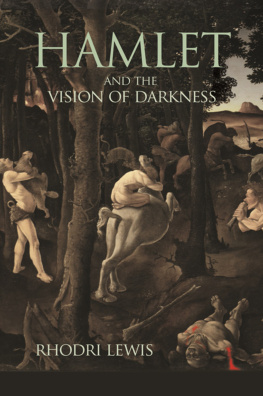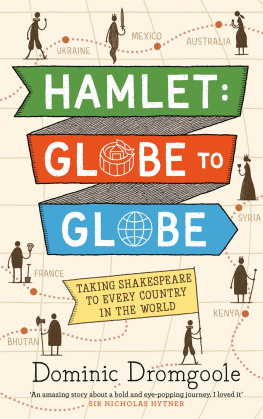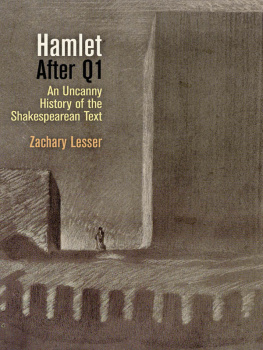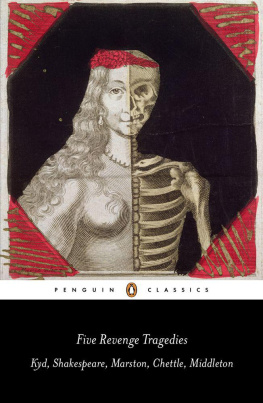Shakespeare  the First Hamlet
the First Hamlet
Shakespeare
Series Editor:
Graham Holderness, University of Hertfordshire
Volume 9
Shakespeare & the First Hamlet
Edited by Terri Bourus
Volume 8
Shakespeare & Biography
Edited by Katherine Scheil and Graham Holderness
Volume 7
Shakespeare & Money
Edited by Graham Holderness
Volume 6
Shakespeare & His Biographical Afterlives
Edited by Paul Franssen and Paul Edmondson
Volume 5
Shakespeare & the Ethics of War
Edited by Patrick Gray
Volume 4
Shakespeare & Creative Criticism
Edited by Rob Conkie and Scott Maisano
Volume 3
Shakespeare & the Arab World
Edited by Katherine Hennessey and Margaret Litvin
Volume 2
Shakespeare & Commemoration
Edited by Clara Calvo and Ton Hoenselaars
Volume 1
Shakespeare & Stratford
Edited by Katherine Scheil
Shakespeare  the First Hamlet
the First Hamlet
Edited by
Terri Bourus

First published in 2022 by
Berghahn Books
www.berghahnbooks.com
2022 Berghahn Books
Originally published as a special issue of Critical Survey, volume 31, numbers 1 and 2, unless otherwise noted.
All rights reserved. Except for the quotation of short passages for the purposes of criticism and review, no part of this book may be reproduced in any form or by any means, electronic or mechanical, including photocopying, recording, or any information storage and retrieval system now known or to be invented, without written permission of the publisher.
Library of Congress Cataloging-in-Publication Data
A C.I.P. cataloging record is available from the Library of Congress
Library of Congress Cataloging in Publication Control Number: 2022012980
British Library Cataloguing in Publication Data
A catalogue record for this book is available from the British Library
ISBN 978-1-80073-553-8 hardback
ISBN 978-1-80073-554-5 paperback
ISBN 978-1-80073-555-2 ebook
https://doi.org/10.3167/9781800735538

Contents
Introduction
Is Q1 Hamlet the First Hamlet?
Terri Bourus
Chapter 1
Shakespeares Early Gothic Hamlet
Gary Taylor
Chapter 2
The Hybrid Hamlet
Christopher Marino
Chapter 3
Ofelias Interruption of Ophelia in Hamlet
Michael M. Wagoner
Chapter 4
Beautified Q1 Hamlet
Douglas Bruster
Chapter 5
The Good Enough Quarto
Terri Bourus
Chapter 6
Harveys 1593 To Be and Not To Be
Dennis McCarthy
Chapter 7
To Be, or Not To Be
Saul Frampton
Chapter 8
Shakespeare, Virgil and the First Hamlet
John. V. Nance
Chapter 9
Unique Lines and the Ambient Heart of Q1 Hamlet
Laurie Johnson
Chapter 10
Brief Let Me Be
Tommaso Continisio
Chapter 11
Q1 Hamlet
Charles Adams Kelly and Dayna Leigh Plehn
Chapter 12
What Doesnt Happen in Hamlet
Rory Loughnane
Afterword
Q1 Hamlet
Graham Holderness and Bryan Loughrey

List of Figures

Introduction
Is Q1 Hamlet the First Hamlet?
Terri Bourus
Many of the questions that we ask about Shakespeares Hamlet depend on what we mean by first. In a book published in 1589, Thomas Nashe refers to a play about Hamlet.
The answers to all those questions depend on our interpretation of another first. The first known printed edition of Hamlet was published in 1603. The title page of the 1603 Tragicall Historie of Hamlet Prince of Denmarke explicitly attributes the play to William Shake-speare and claims that it was performed by the company of actors to which Shakespeare belonged. That edition is often called Q1, shorthand for first quarto (referring to the bibliographical format most often used for early editions of plays, a quarto). It was followed by an expanded second edition, also a quarto, also attributed to William Shakespeare (Q2). After Shakespeares death, another distinct version of the play was included in the big, expensive, hardbound 1623 folio collection of thirty-six of Shakespeares Comedies, Histories, and Tragedies (F, F1 or the Folio). Q1 is the rarest of these three important early editions of Shakespeares most famous play; it survives in only two known copies. It has had less influence on critical and theatre history than the other two early versions. In fact, all three early versions have been eclipsed by a fourth version, created by eighteenth-century editors, which combined material from both Q2 and F. That conflated editorial version is the text that almost all readers and performers think about when they think about Hamlet. In the overwhelming majority of editions of Shakespeare from the last three centuries, that omnibus, conflated edition of the tragedy, the last version to appear in any surviving printed or manuscript text, is assumed to be the first Hamlet. As a result, the three editions printed between 1603 and 1623 are all dismissed on the assumption that, in different ways and to different degrees, each is a defective derivative from Shakespeares hypothetical first manuscript of the play.
The foundations of modern Shakespeare scholarship were established before editors and critics were even aware of the existence of Q1. In 1823, a defective copy of the first edition was discovered, These two books were conceived and written independently of each other; they address different issues in different styles; they have tended to appeal to different readers. But they both challenged the orthodox assumption, which had dominated Shakespeare scholarship for a century, that Q1 could simply be ignored.
What the editions and monographs of the last thirty years have done, collectively, is to begin to canonize Q1 Hamlet. No one can claim that there is now a universal consensus about what Q1 is, or what it means, or how it came to be. In fact, the canonicity of works of art is usually accompanied by intense disagreements about how to interpret them. For most of the twentieth century, Shakespearians who agreed about nothing else agreed that they didnt need to worry much about the first edition of Shakespeares most famous play. Q1
Next page









 the First Hamlet
the First Hamlet